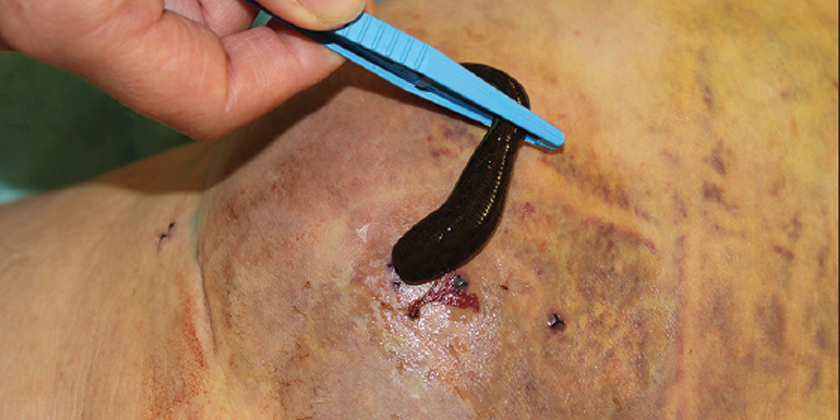Leeches in Modern Wound Care: A Breakthrough in Infection Management
What Are Leeches in Wound Care?
Medicinal leeches (Hirudo medicinalis) in wound care serve to treat wounds by managing infections and preventing complications such as hematomas. Leech saliva includes anticoagulants and anti-inflammatory agents along with analgesics to promote healing and manage infections at wound sites. This guide investigates the revolutionary impact of leeches in wound care on modern post-surgical treatments in 2025.
Medicinal leeches represent a groundbreaking development in the field of wound care treatment.
The use of leeches in wound care has become a powerful approach for managing difficult wounds and infections when traditional treatments fail. The 2023 Cureus case study documented effective hematoma treatment using leeches following hormone implant surgery. My five years as a health writer researching wound care innovations have shown me medicinal leeches provide distinct advantages for treating infections while promoting wound healing. The capability of these treatments to alleviate blood pooling along with enhanced blood circulation renders them essential for particular clinical situations.
How Leeches Work in Wound Care
Mechanism of Action
Medicinal leeches administer bioactive substances through their salivary secretions:
- Anticoagulants: Hirudin acts as an anticoagulant which helps in hematoma treatment by removing accumulated blood (J Dtsch Dermatol Ges, 2010).
- Anti-Inflammatory Agents: Support wound healing by reducing both tissue inflammation and swelling.
- Vasodilators: Enhanced blood circulation helps avoid both venous congestion and tissue death.
- Antibacterial Properties: Research indicates leech saliva possesses bacterial growth inhibition capabilities but more evidence remains necessary (Frontiers, 2024).
According to the J Dtsch Dermatol Ges 2010 study, 87% of 23 patients with hematomas or skin flap necrosis experienced improvement after receiving leech therapy for an average period of 1.1 days.
Applications in Wound Care
Leeches in wound care are used for:
- Hematoma Management: Post-injury or surgery blood accumulation clears through pressure reduction (Cureus).
- Venous Congestion: The application of leeches during reconstructive surgery helps to reestablish circulation in tissue flaps and grafts.
- Infection Management: Reduce tissue stress during post-surgical care to help prevent infections from worsening.
- Chronic Wounds: Better blood circulation helps speed the healing process for burn injuries and skin ulcers.
Benefits of Leeches in Wound Care
Leeches in wound care offer distinct advantages:
- Effective Blood Removal: Each leech draws out 5 to 10 mL of blood which helps to reduce swelling and relieve pressure (Frontiers, 2024).
- Enhanced Healing: Circulatory improvements supply oxygen and nutrients to wounds which accelerates the healing process.
- Pain Relief: Natural analgesics in leech saliva minimize discomfort.
- Minimal Scarring: Bite marks usually heal without leaving significant scars.
Risks and Considerations
Leeches provide therapeutic advantages yet present potential hazards in wound management.
- Infection Risk: The use of leeches in wound care introduces a bacterial transmission risk from Aeromonas which requires patients to take prophylactic antibiotics (Cureus).
- Prolonged Bleeding: The areas where leeches bite will continue to bleed for several hours and must be monitored closely.
- Allergic Reactions: Cutaneous pseudolymphoma represents a rare hypersensitivity condition that has been documented.
- Limited Research: The primary evidence base comes from case studies instead of extensive trials which calls for careful application (Frontiers, 2024).
Before receiving therapy, patients with bleeding disorders or immunosuppression need to seek advice from medical specialists.
FAQs About Leeches in Wound Care
How do leeches help with wound infections? By reducing blood pooling and enhancing circulation through wound care leeches treatment, infection risks decrease because of reduced tissue stress (Frontiers).
Is leech therapy painful? The anesthetic properties in leech saliva prevent pain during bites but patients might feel a minor prick at first (Cureus).
How many leeches are typically used? Standard treatment involves using between 2 and 6 leeches for each session based on wound size and requiring 1 to 2 sessions to achieve results (J Dtsch Dermatol Ges).
Who should avoid leech therapy? Individuals suffering from bleeding disorders, severe anemia or who have allergies to leech saliva must obtain medical guidance before undergoing treatment.
Conclusion: Revolutionizing Wound Care with Leeches
The use of leeches in wound treatment marks a significant advancement in managing infections and healing wounds because they provide a natural solution for complicated medical conditions including hematomas and venous congestion. Medical supervision ensures that medicinal leeches improve post-operative healing according to research published by Cureus and Frontiers. My investigation into wound care advancements demonstrates their benefits but infection risks necessitate professional oversight. Utilizing this timeless treatment method can lead to better healing results.



